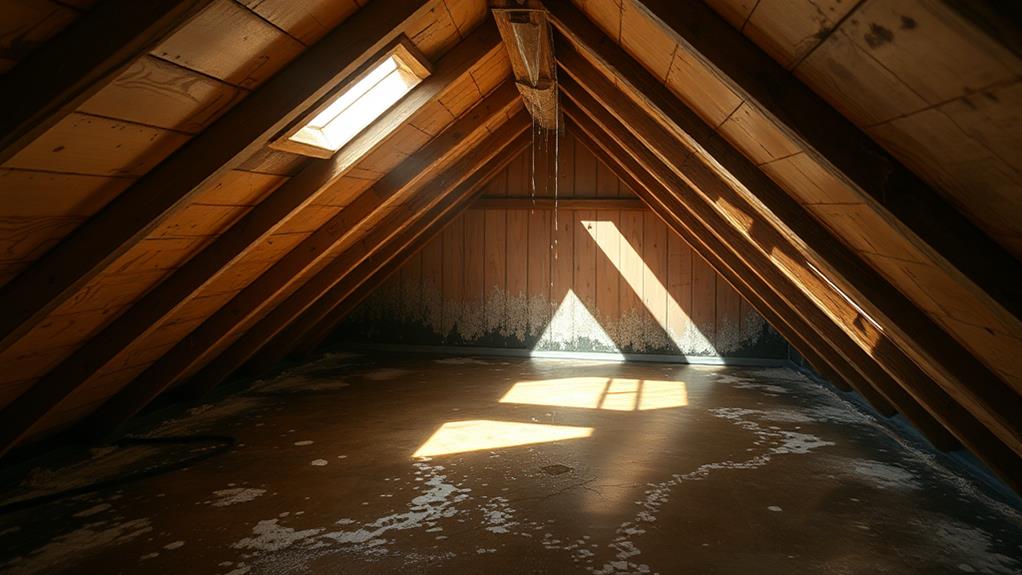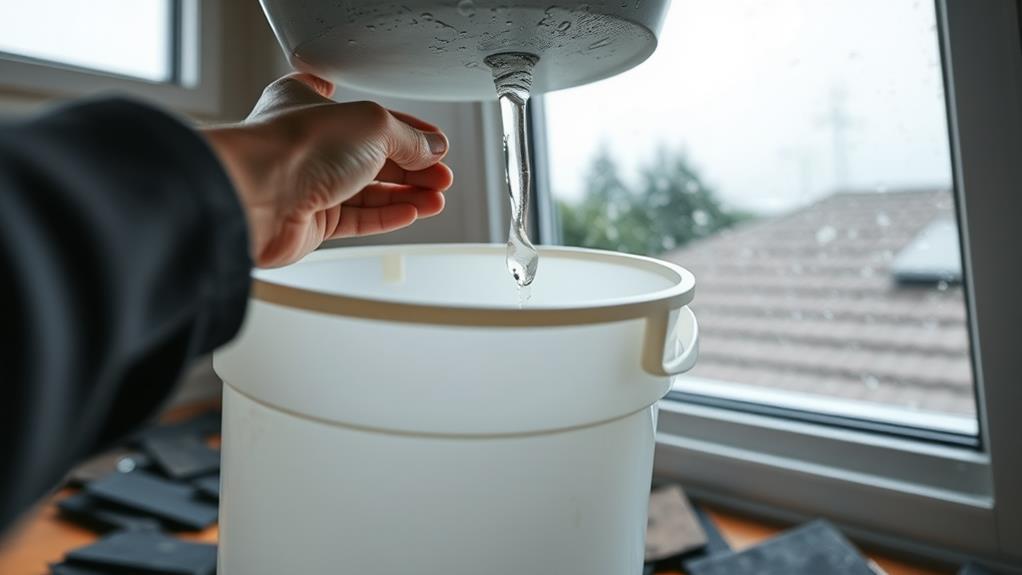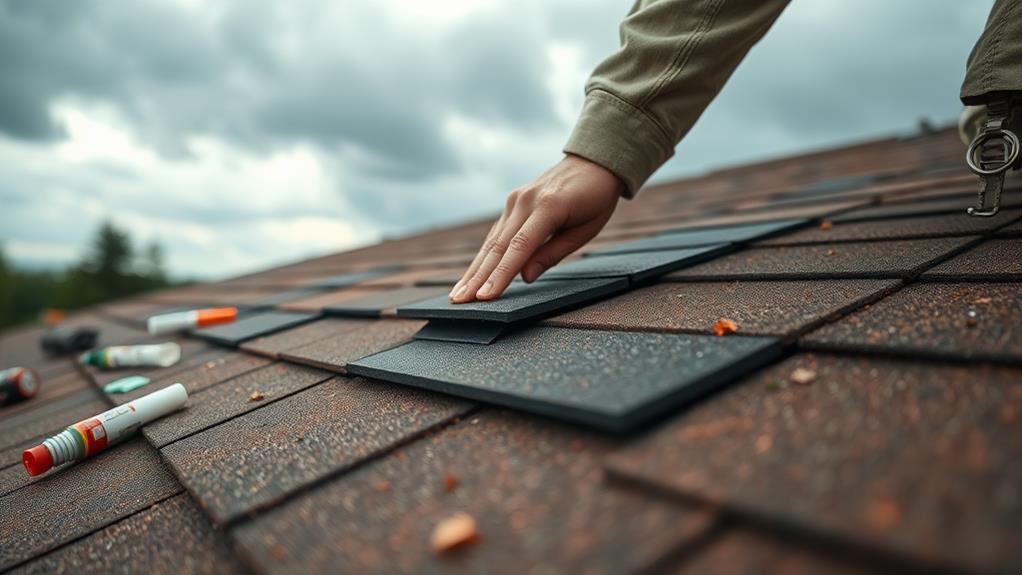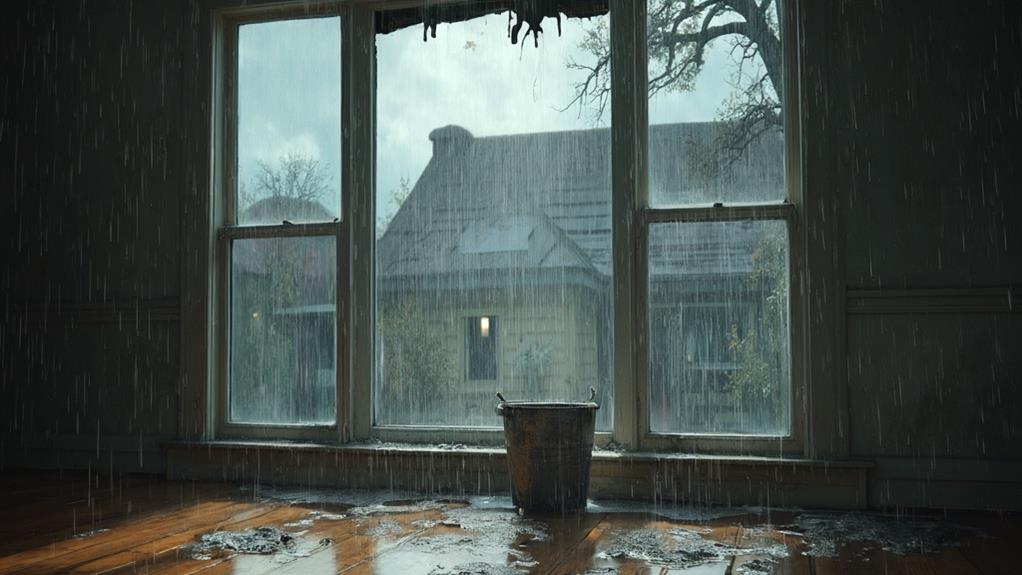After a storm, identifying a roof leak is crucial. Look for water stains, peeling paint, or damp spots on interior surfaces. Storm damage often results from high winds, hail, heavy rainfall, or debris impact. Take immediate action by placing containers to collect water, moving valuables, and documenting the damage. While minor issues may be suitable for DIY repairs, professional roofers offer expertise, proper equipment, and long-term warranties. To prevent future leaks, schedule regular inspections, maintain gutters, trim overhanging branches, and consider impact-resistant roofing materials. Understanding these key points is just the beginning of effectively managing storm-related roof damage.
Identifying Roof Leak Signs

Following a severe storm, identifying signs of a roof leak is crucial for preventing further damage to your home. Look for water stains or discoloration on ceilings and walls, which may indicate water seeping through the roof. Pay attention to peeling paint or bubbling wallpaper, as these can also be signs of moisture infiltration. Check for damp spots or water droplets on interior surfaces, especially in attics or upper floors.
Inspect the exterior of your roof for missing, damaged, or curled shingles, as well as exposed nails or loose flashing around chimneys and vents. These vulnerabilities can allow water to penetrate your roof's protective barrier. Look for granules from asphalt shingles in your gutters or on the ground, which may indicate roof deterioration.
Inside your home, be alert for musty odors or the sound of dripping water, particularly during or after rainfall. Examine your attic for wet insulation, water stains on rafters, or daylight visible through the roof boards. If you notice any of these signs, it's essential to address the issue promptly to prevent more extensive damage and potential mold growth.
Common Causes of Storm Damage
Severe weather events can wreak havoc on residential roofs, leading to various types of damage. High winds are a primary culprit, capable of lifting and tearing off shingles, exposing the underlying roof structure to water infiltration. Wind-driven debris, such as tree branches or loose outdoor objects, can puncture or crack roofing materials upon impact.
Hailstorms pose another significant threat, with large hailstones potentially denting or cracking shingles, damaging flashing, and compromising the roof's protective layer. Heavy rainfall can overwhelm gutters and drainage systems, causing water to back up and seep under shingles or pool on flat roofs. This standing water can lead to leaks and structural damage over time.
Lightning strikes, though less common, can cause severe localized damage, potentially igniting fires or creating entry points for water. Extreme temperature fluctuations during storms can also contribute to roof deterioration, as rapid expansion and contraction of roofing materials may lead to cracks or separation. Additionally, the weight of accumulated snow or ice during winter storms can stress roof structures, potentially causing collapse in severe cases.
Immediate Actions to Take

When a roof leak is discovered after a storm, swift action is crucial to minimize damage and protect your home's interior. Begin by safely locating the source of the leak, if possible. Place buckets or containers under dripping areas to collect water and prevent further damage to floors and furnishings. Move valuable items away from affected areas and cover immovable objects with waterproof tarps or plastic sheeting.
If water is accumulating in ceiling cavities, carefully puncture the ceiling at its lowest point to release the water and prevent collapse. Use towels or mops to remove standing water from floors and surfaces. Turn off electrical circuits in affected areas to avoid potential hazards. Document the damage by taking photos and videos for insurance purposes.
Contact a professional roofing contractor immediately for emergency repairs or temporary solutions, such as installing a tarp over the damaged area. Inform your insurance company about the situation and begin the claims process. Ventilate the affected areas by opening windows and using fans to promote air circulation and prevent mold growth. These immediate actions will help mitigate damage and set the stage for proper repairs.
Professional Repair vs. DIY Solutions
Homeowners often grapple with the decision between professional repair and do-it-yourself solutions when addressing a leaky roof after a storm. While DIY repairs may seem cost-effective, they can lead to further damage if not executed correctly. Professional roofers possess the expertise, tools, and safety equipment necessary to accurately assess and repair storm damage.
DIY solutions are best suited for minor issues like replacing a few shingles or applying a temporary sealant. However, more extensive damage, such as structural issues or large-scale water infiltration, requires professional intervention. Roofing experts can identify hidden problems that may not be apparent to untrained eyes, preventing future leaks and potential property damage.
Professional repairs often come with warranties, ensuring long-term protection for your investment. Additionally, licensed contractors are familiar with local building codes and can obtain necessary permits. While the upfront cost of professional repair may be higher, it often proves more economical in the long run by preventing recurring issues and extending the roof's lifespan. Ultimately, the decision between professional and DIY solutions depends on the extent of the damage and the homeowner's skill level.
Preventing Future Roof Leaks

After addressing immediate storm damage, the focus shifts to preventing future roof leaks. Regular maintenance is crucial for long-term roof protection. Schedule annual inspections by a qualified roofing professional to identify potential issues before they escalate. These inspections should include checking for damaged or missing shingles, examining flashing around chimneys and vents, and assessing the overall integrity of the roof structure.
Keep gutters and downspouts clean and free of debris to ensure proper water drainage. Trim overhanging tree branches to prevent damage from falling limbs during storms. Consider installing impact-resistant shingles or a metal roof for enhanced durability against severe weather. Proper attic ventilation and insulation can also help prevent ice dams and moisture buildup, which can lead to leaks.
Regularly inspect your attic for signs of water intrusion, such as dark spots on the ceiling or walls. Address any issues promptly to prevent further damage. Apply a waterproof sealant to vulnerable areas, such as around skylights or roof penetrations. Finally, maintain accurate records of all roof repairs and inspections to track the roof's condition over time and anticipate when a full replacement may be necessary.
Frequently Asked Questions
How Long Does a Typical Roof Repair Take to Complete?
The duration of a typical roof repair can vary significantly depending on the extent of damage and repair type. Generally, minor repairs may take a few hours, while more extensive repairs can span several days to a week.
Can I Claim Roof Damage on My Homeowner's Insurance?
Like a shield protecting your castle, homeowner's insurance often covers roof damage. However, coverage depends on your policy's specifics and the cause of damage. Review your policy or consult your insurance agent to determine eligibility for a claim.
What's the Average Lifespan of Different Roofing Materials?
The average lifespan of roofing materials varies significantly. Asphalt shingles typically last 20-30 years, metal roofs 40-70 years, clay tiles 50-100 years, and slate roofs can exceed 100 years. Regular maintenance can extend these lifespans considerably.
Are There Specific Weather Conditions That Increase the Risk of Roof Leaks?
Several weather conditions can increase the risk of roof leaks. Heavy rainfall, strong winds, hailstorms, and rapid temperature fluctuations can all stress roofing materials. Snow accumulation and ice dams in colder climates also pose significant risks to roof integrity.
How Often Should I Have My Roof Professionally Inspected?
Professional roof inspections should be conducted annually, or biannually for older roofs. Additionally, schedule inspections after severe weather events. Regular inspections help identify potential issues early, preventing costly damages and extending your roof's lifespan.
Conclusion
A storm-battered roof, like a shield with chinks in its armor, demands swift attention. Armed with knowledge of leak signs, storm damage causes, and immediate remedies, homeowners can weather the aftermath effectively. While professional repairs offer expertise, DIY solutions may suffice for minor issues. Ultimately, prevention is the keystone of roof integrity. By implementing proactive measures, one fortifies the home's crown against nature's onslaught, ensuring a dry sanctuary beneath the turbulent skies.

